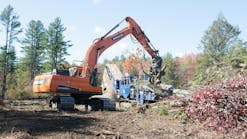The trend toward tool carriers has not been automatic. Traditionally wheel loaders have been made with two boom linkage systems. One is a parallel linkage made to mount attachments, and the second is a Z-bar linkage, used mainly for buckets made to dig–not for a variety of attachments. The parallel linkage is designed to keep the loaded bucket or forks parallel to the ground throughout the lift. And the Z-bar linkage has achieved considerable popularity because it provides better tilt breakout forces for use in digging into a pile of material. The traditional Z-bar linkage, however, cannot hold a load parallel to the ground throughout the lift.“Since the introduction of the integrated tool carrier [ITC] more than 17 years ago, we have seen the industry in North America move progressively toward the IT machine,” says Andy Cruickshank, marketing supervisor for small wheel loaders at Caterpillar. Some 13 or 14 years ago, the split between tool-carrier machines and Z-bar linkages was about 50/50 among North American sales of Caterpillar machines. In recent years, however, sales of tool-carrier machines have grown to more than 65% of the total, and that number has seen a recent, substantial increase, Cruickshank says.
Caterpillar gives considerable credit for that increase to sales of its newly designed 924G wheel loader. According to Cat, the 924G combines all the versatility of an ITC with the strong performance characteristics of a dedicated wheel loader (Z-bar linkage). Introduced in January 2000, the 924G replaced both the IT24F tool-carrier model and the 924F wheel loader.Cat claims that the key to the 924G is the company’s one-piece, fabricated box-section design of the new VersaLink Loader Linkage. The new linkage replaces both the 8-bar parallel-lift linkage used on Cat’s ITCs and the Z-bar linkage found on wheel loaders. “The VersaLink machine has better breakout force than the previous Z-bar machine,” notes Cruickshank, “and it also has the same parallel-lift capability of a tool-carrier machine.” The 924G with VersaLink Loader Linkage features a hydraulic quick coupler so that work-tool changes can be made quickly. “So you get the benefits of a Z-bar linkage and an integrated tool carrier in one machine,” Cruickshank states. “For a customer, that is a major step forward because essentially it gives him a lot more versatility. He can have a very well-performing digging machine one day and a tool carrier the next day–and he has not lost any of the performance capability of either type of machine.” InterchangeabilityThis wheel loader features better breakout force than Cat’s previous Z-bar machine and has the same parallel-lift capability of a tool-carrier machine.“What makes Caterpillar wheel loader/IT machines so successful is the interchangeability of the work tools,” says Cruickshank. “Tools can be shared across the whole small wheel-loader line, and the same tools can be used on previous models of Cat’s small wheel loaders and also backhoe loaders and telehandlers.” Dozens of attachments can fit onto any of the following Caterpillar machines: Small wheel loaders–the IT14G (90 hp), the 924G (114 hp), and the IT28G (125 hp); Backhoe loaders–the 416D, the 420D, and the 430D; Telehandlers–the TH62, the TH82, the TH63, the TH83, and the TH103.“The coupler interface that we use on today’s telehandlers, today’s IT-equipped backhoe loaders, and the small wheel loader/IT machines is exactly the same,” points out Cruickshank. “So you’d be able to take a hydraulically operated broom that you run on a backhoe loader or a telehandler, you could drop it off that machine and pick it up with the IT machine, and it will fit right on there with no change required.” Easing Operator WorkloadJohn Deere offers three tool-carrier models–the 110-hp TC44H, the 130-hp TC54H, and the 160-hp TC62H. Among the latest features on Deere tool carriers is “smart shift technology,” which evaluates the machine’s speed and load conditions, then matches them by adjusting the transmission shift engagement speed of the clutch pack. Smart shift technology, says Deere, delivers smoother shifts with less delay under all load conditions. The automatic shift feature consists of three choices: (1) operator-select manual shift; (2) automatic, first through fourth gears; and (3) automatic, second through fourth gears, any of which the operator can select from the seat. According to Deere, the quick-shift button on the loader’s boom raise lever also provides the operator with two easily selectable choices: (1) Press once to shift down one gear, then press again to shift back up, and (2) press once to shift down, then press repeatedly to shift all the way down to first gear. In addition, Deere tool carriers have an exclusive multiple-sensitivity clutch cutoff, says Doug Meyer, business analysis manager for material handling. “If you’re loading a truck on level ground, set the clutch cutoff to ‘level,’” says Meyer. “When you step on the brake, the transmission goes to neutral with very little braking force, so you can roll up to the truck. But if you’re on a slope, you can set the clutch for ‘small’ or ‘steep slope.’ Then when you step on the brake, more braking force is applied before the transmission shifts to neutral, so you don’t roll back down the hill or into a ditch.” Deere tool carriers also feature pressure-compensated load-sense hydraulics, which is similar to what many excavators have. The feature allows the operator to control implement speed regardless of load, resulting in more precise control of function. Also, only the pressure and flow needed to operate a given function is delivered, which results in more efficient operation.Deere’s parallel-lift tool carriers offer improved visibility down the center of the boom, which is especially helpful for fork applications. And the tool carriers feature level lift from ground to full boom height, with no need to adjust the angle of the fork tines while lifting.Visibility and Functionality Are KeyThe WA180PT-3MC has greater visibility and the added benefits of parallel lift and a hydraulically actuated quick coupler.Komatsu America International Company markets two models of tool carriers, the WA180PT-3MC and the WA250PT-3MC. The two have 120 hp and 131 hp, respectively. The WA180PT-3MC is the company’s most recent addition to its Avance Plus wheel-loader line. “This is a bigger, better and tougher machine with greater visibility,” says Steve Moore, Komatsu America wheel-loader product manager. “The WA180PT-3MC has been designed for rugged use in the road-building, landscape, home-construction, and utility markets.” The WA180PT-3MC has the same advantages as its Dash-3 Avance Plus wheel-loader counterpart, with the added benefits of parallel lift and a hydraulically actuated quick coupler. The quick coupler enables the operator to easily attach and detach work equipment, all without leaving the cab. The WA180PT-3MC is available with a variety of attachments, including construction forks, material-handling arms, side-dump buckets, rotary brooms, four-in-one buckets, snowplows, and log forks.The WA180PT-3MC has one of the largest cabs ever offered on a Komatsu wheel loader in this class. Operator comfort is improved, if the customer so chooses, by the addition of an optional air-ride seat. Noise is reduced in the cab to 75 dBa. Pilot hydraulic controls decrease the operator force needed to operate the wheel loader. Proportional pressure-controlled joystick hydraulic controls also contribute to simplifying operation and minimizing operator fatigue. The tool carrier also includes 180º opening, rear-hinged doors for easier entrance and exit. An added benefit is the combination–designed for maximum visibility–of the front linkage, quick coupler, and large, flat-glass windshield.Komatsu claims that the standard automatic, four-speed transmission of the WA180PT-3MC reduces operator fatigue that can result from constant shifting. The four forward and four reverse speeds of the electronically controlled transmission permit travel speeds up to 20.8 mph. A transmission hold switch allows the operator to select either automatic or manual shifting. With a touch of the finger, a transmission kickdown switch automatically downshifts from second to first gear when beginning the digging cycle. The transmission automatically upshifts from first to second when the direction control lever is placed in reverse.The WA250PT-3MC is a very similar machine to the WA180PT-3MC, except that it’s larger and more powerful. Powered by a Komatsu 131-hp engine, the WA250PT-3MC has an operating weight of 27,540 lb. and features a breakout force of 24,575 lb. The machine has a bucket range of 2.5-3.0 yd.3 Similar to its sibling tool carrier, the WA250PT-3MC has a parallel-lift boom that keeps loads level throughout the boom’s lifting arc.Automated Functions Increase ProductivityVolvo Construction Equipment North America Inc. markets four tool-carrier models as wheel loaders: the 101-hp L50D, the 124-hp L70D, the 153-hp L90D, and the 201-hp L120D. Leading the list of features on Volvo tool carriers is the TP linkage, the company’s patented lift-arm system. Volvo states that the linkage offers “superior breakout torque throughout the lifting range, combined with parallel lift-arm action.” According to the company, TP linkage is superior to both Z-bar and conventional parallel systems at handling buckets and other attachments. And Volvo claims that the “visibility-optimized attachment bracket and refined TP linkage” give the operator a clear view of the attachment and load. Volvo’s D-series “all-rounders” (the L50D and L70D) include the following features: A boom suspension system (BSS) uses nitrogen/oil accumulators connected to the lift cylinders to absorb shocks and smooth out rough roads. The BSS has two modes, gear dependent or speed dependent, to match any job condition.A factory-mounted automatic lubrication system handles the required greasing while the machine operates its normal work cycle. The Contronic II monitoring system keeps an eye on all vital machine systems and functions to warn the operator of problems or faults. Warning messages and operating information are shown in plain text on the dashboard-mounted display screen. Volvo’s automatic shifting system on the L70D, called APS II, monitors both engine speed and ground speed to provide optimum control of gear shifting in any application. The customer can choose one of four different shifting modes to customize machine performance to the job at hand. A first-gear kickdown button and forward-reverse rocker switch mounted on the hydraulic console allow the operator to operate the APS II system with his right hand while the left hand steers.The L50D features a hydrostatic transmission with a high and low speed range and an inching function for precise control of ground speed.Volvo’s load-sensing hydraulic system uses variable-displacement piston pumps to circulate oil only when and where needed. That saves fuel and conserves engine power for greater penetration when loading the bucket, and it speeds cycle times. Advancements in CoolingTP linkage offers “superior breakout torque throughout the lifting range, combined with parallel lift-arm action.”Case Construction Equipment offers three tool-carrier models: the 521D XT with 110 hp, the 621C XT with 130 hp, and the 721C XT with 52 hp, says David Wolf, marketing manager for Case wheel loaders and excavators.Recently introduced, the 521D XT features an industry-first midmount, cube-shaped cooling system. “It’s a midmount module of coolers that includes the transmission oil cooler, the engine oil cooler, the hydraulic oil cooler, and the fuel cooler,” explains Wolf. “And on top you have your air-conditioning condenser. “The beauty of the midmount cooling module is that it’s located right behind the cab; that way you get cleaner air going to the cooling module.” Case says the cooling-system design prevents debris from plugging between the coolers. A large, hydraulically driven engine fan is quieter and highly efficient. An optional reversible fan is useful for especially dusty conditions; by simply engaging a switch from the seat of the cab, the operator can reverse the fan and airflow, which purges any material trapped in the coolers.“The midmount cooling system is revolutionary for its efficiency, function, and ease of maintenance,” remarks Wolf. “The innovative design allows the engine to be mounted at the rear of the machine, which shifts weight to the rear and makes the wheel loader more balanced.” A closed-center, load-sensing hydraulic system on the 521D provides optimum flow and power to all hydraulic functions as needed. The system senses when more flow and pressure are required and adjusts automatically, which provides better fuel economy. “Operators will appreciate the smart hydraulics on the 521D,” says Wolf. “It’s noticeable in the cycle times, quick responsiveness, quieter operation of the machine, and longer component life.” All daily maintenance points can be reached from ground level. Remote drains for engine oil, hydraulic oil, and engine coolant are grouped in one location for convenience. The rear-mounted engine–accessible under a flip-up hood–provides greater room and accessibility for daily checkpoints.As Wolf also notes, the 521D maximizes traction in slippery conditions with standard limited-slip axles in the front and rear. “That feature transfers more power to the wheel that’s not slipping so you can pull yourself out.”The 521D features a proportional-shift transmission that provides smooth shifting in four forward and three reverse speeds. The transmission offers fully automatic or semiautomatic options to maximize productivity. “We also have a forward and reverse fast shuttle switch,” says Wolf. “Typically you’ve got a joystick for boom control. On the joystick we have a thumb switch for forward, neutral, and reverse. That way you can switch direction from forward to reverse without your hand leaving the steering wheel.” Operator visibility has been increased on the 521D; it has 42.5 ft.2 of glass, which is an 11% increase in both the front and rear, with fewer visual obstructions. The view to the rear is enhanced, Wolf points out, by the downward curving design of the rear hood. He adds that Case will have the 621C changed over to a D model by the end of this year.Upgraded Monitoring and Display SystemsJCB Inc. offers four models of tool carriers: the 83-hp model 411HT, the 108-hp model 416HT, the 132-hp model 426HT, and the 150-hp model 436HT. A leading feature on the JCB tool carrier is single-lever control over the boom and bucket, says Dan Snedecor, product marketing manager for wheel loaders. In that single lever is an integrated forward and reverse switch so that the operator doesn’t have to remove his hand from the steering wheel to change direction. “We use piston-pump hydraulics on our machines,” says Snedecor. “Piston pumps improve fuel efficiency and smoothness of hydraulic action.“And we have a new smooth-shift transmission,” he continues. “It’s an automatic transmission, and we improved the modulation in gear changes and direction changes. That translates into increased climbing speed, traveling speed, and cycle speed.“We have a new cab, and in that cab we have tilt steering and a six-way—adjustable suspension seat. An air-ride seat is optional. And we have an electronic monitoring system that we call EMS. It provides at-a-glance viewing of your major system gauges as well as travel speed and engine rpms. You can use a laptop computer to download information about the performance of the machine. And we didn’t put it behind the steering wheel where it would distract the operator; it’s down and to the right side.” Snedecor says JCB’s tool carriers have indicators on the quick-hitch coupler–visible from the cab–that indicate whether the pins are engaged in the implement or retracted into the coupler. “So that’s a benefit in terms of safety,” he remarks. Another significant feature is the gull-wing design of the engine-compartment side panels. “We don’t have small doors or side panels,” states Snedecor. “The entire door swings up to provide access to the engine.” He points out that JCB has been manufacturing wheel loaders since 1970.Refined Functionality and Friendliness of ControlsCase’s midmount cooling system design allows the engine to be mounted at the rear of the machine, which shifts weight to the rear and makes the wheel loader more balanced.New Holland Construction offers two tool-carrier models as wheel loaders: the 130-hp LW 130 TC and the 170-hp LW 170 TC. In addition, New Holland markets four backhoe loader models. The LB75.B, the LB90, the LB110, and the LB115.B all have a quick-coupler system available. Those models go hand in hand with a wide variety of tools, including a standard bucket, a broom, an auger, a grader rake, a material-handling boom, a grapple bucket, and a four-in-one bucket. Hydraulics on the wheel loaders comes equipped with a pilot valve system that permits fingertip control. “That makes it a low-effort system, which cuts down on operator fatigue,” notes Sam Wyant, New Holland Construction’s product manager for wheel loaders. He says another leading feature is a supplemental transmission control switch, which has forward, neutral, and reverse positions and allows the operator to change directions with his right hand. That way the operator’s left hand never leaves the steering wheel. New Holland’s tool carriers have four forward speeds and four reverse speeds.“The cab on our machine has world-class operating comfort,” Wyant remarks. “It’s got a seamless front windshield, where others have a beaded or structural seam. All our cabs have air-ride seats and air conditioning as standard. And we have a quiet, 74-dBa operating environment.” Competition among wheel-loader manufacturers has driven them all to offer progressive, industry-leading features. In summary, contractors can choose from the widest range ever of options in both tool carriers and attachments.


